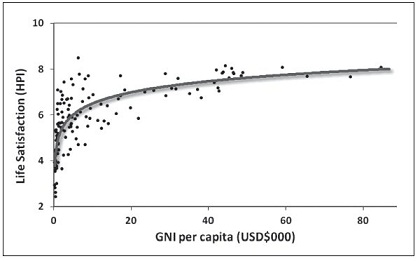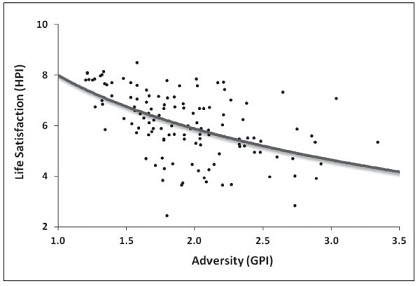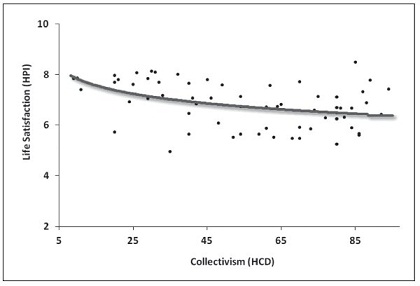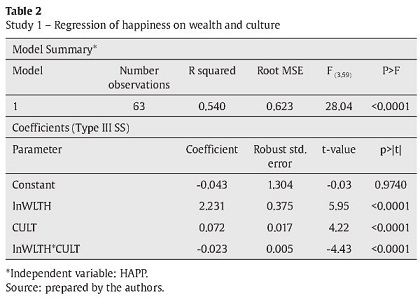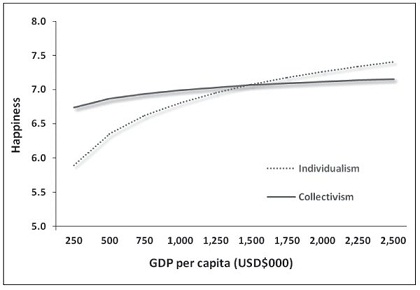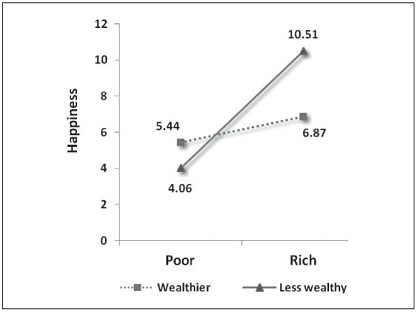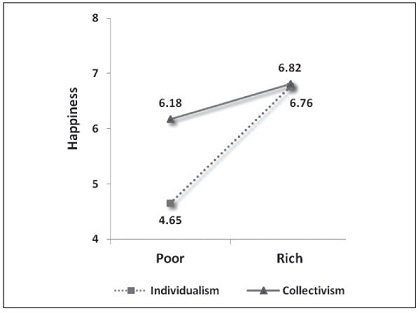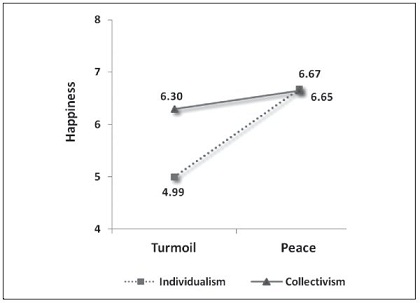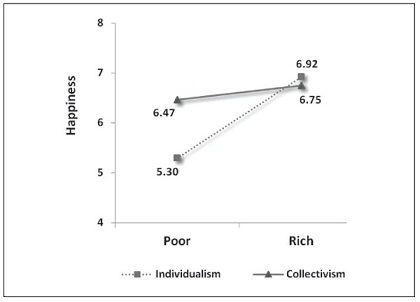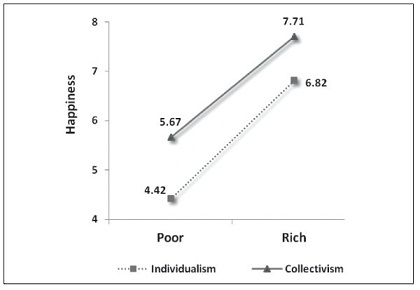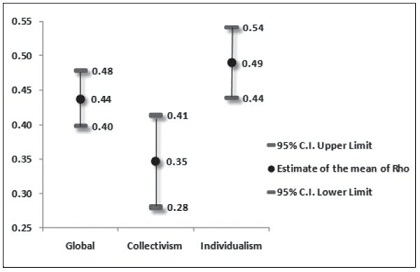Services on Demand
Journal
Article
Indicators
-
 Cited by SciELO
Cited by SciELO -
 Access statistics
Access statistics
Related links
-
 Cited by Google
Cited by Google -
 Similars in
SciELO
Similars in
SciELO -
 Similars in Google
Similars in Google
Share
Estudios Gerenciales
Print version ISSN 0123-5923
estud.gerenc. vol.29 no.126 Cali Jan./Mar. 2013
ARTÍCULOS
Poor and distressed, but happy: situational and cultural moderators of the relationship between wealth and happiness
Pobres y afligidos pero felices: efectos moderadores de índole cultural y situacional en la relación entre riqueza y felicidad
Pobres e angustiados, mas felizes: moderadores situacionais e culturais da relação entre riqueza e felicidade
Silvio Borreroa, Ana Bolena Escobarb, Aura María Cortésc, Luis Carlos Mayad
aJefe del Departamento de Gestión Organizacional, Universidad Icesi, Cali, Colombia
bDirectora de Economía y Negocios Internacionales, Universidad Icesi, Cali, Colombia
cEstudiante de Economía y Negocios Internacionales, Universidad Icesi, Cali, Colombia
dEstudiante de Administración de Empresas, Universidad Icesi, Cali, Colombia
*Autor para correspondencia: Departamento de Gestión Organizacional, Universidad Icesi, Calle 18 N.° 122-135, Cali, Colombia Correo electrónico: sborrero@icesi.edu.co (S. Borrero).
Historia del artículo:
Recibido el 4 de julio de 2011
Aceptado el 22 de marzo de 2013
Abstract
Evidence on the relationship between wealth and happiness is mixed, hinting that there are situational or individual factors that account for the variability in results. This paper contends that wealth is in fact related to happiness. More specifically, it is proposed that poverty - as well as other adverse situations- has an undermining effect on happiness, and that this effect is attenuated by a collectivist orientation. Analyses of variance (ANOVAs) using data on happiness, wealth and culture from 197 countries, supplemented by a meta- analysis of empirical studies that explore the relationship between wealth and perceptions of happiness, support the hypothesized relationship between adversity and happiness, and the moderating effect that collectivism has on such relationship.
Keywords: Wealth, Poverty, Happiness, Adversity, Collectivism.
Clasificación JEL: M31
Resumen
La evidencia sobre la relación entre riqueza y felicidad es confusa, sugiriendo que existen factores situacionales o individuales que explicarían la variabilidad de resultados. Este trabajo propone que la riqueza sí está relacionada con la felicidad. Más específicamente, se propone que la pobreza –al igual que otras situaciones adversas– tiene un efecto negativo sobre la felicidad, y que este efecto se ve atenuado por una orientación colectivista. Análisis de varianza, usando datos de felicidad, riqueza y cultura de 197 países, complementados por un metanálisis de estudios empíricos que exploran la relación entre riqueza y felicidad, soportan la relación hipotetizadas entre adversidad y felicidad, y el efecto moderador que el colectivismo tiene sobre tal relación.
Palabras Clave: Riqueza, Pobreza, Felicidad, Adversidad, Colectivismo.
JEL Clasification: M31
Resumo
A evidência sobre a relação entre riqueza e felicidade é confusa, sugerindo que existem factores situacionais ou individuais que explicam a variabilidade de resultados. Este trabalho propõe que a riqueza está relacionada com a felicidade. Mais especificamente, propõe-se que a pobreza - tal como outras situações adversas - tem um efeito negativo sobre a felicidade, e que este efeito é atenuado por uma orientação colectivista. Análise de variância (ANOVAs) utilizando dados de felicidade, riqueza e cultura de 197 países, complementados por uma meta-análise de estudos empíricos que exploram a relação entre riqueza e felicidade, suportam a relação hipotética entre adversidade e felicidade e o efeito moderador que o colectivismo tem sobre tal relação.
Palavras-chave: Riqueza Pobreza Felicidade Adversidade Colectivismo
Classificação JEL: M31
''I don't care too much for money, money can't buy me love'' Paul McCartney, 1964.
1. Introduction
Lay people's beliefs, philosophies, religions, and folklore tend to dismiss wealth or material well-being as valid sources of such central human affects as love or happiness. And yet, there is significant evidence supporting the notion that happiness does relate to economic well-being, such that increasing wealth is positively associated with enhanced perceptions of happiness (Csikszentmihalyi, 1999; Diener, Diener & Diener, 1995; Mentzakis & Moro, 2009; Michaelson, Abdallah, Steuer, Thompson, Marks, Aked, et al., 2009). Such evidence, however, is often mixed or openly contradictory. Many studies suggest that there is no direct relationship between wealth and happiness, that returns in happiness diminish as people accumulate more and more possessions (Csikszentmihalyi, 2000a; Van Boven, 2005), and that happiness could actually decrease after a certain threshold in the level of material well-being. Overall, increasing income and correspondingly intensive consumerism have proven quite ineffective–or at least inefficient–in improving people's happiness over time (Myers, 2000). This intriguing paradox has called for alternative, and often opposing, economical (Easterlin, 1974, 2001; Frey & Stutzer, 2002; Tella & MacCulloch, 2008; Tideman, 2001; Veenhoven & Hagerty, 2006), psychological (Buchanan, 1991; Day & Maltby, 2003; Deci & Ryan, 2000; Diener & Selicman, 2006; Steel & Ones, 2002), or sociological (Ahuvia, 2002; Csikszentmihalyi, 2000b; Diener & Diener, 1996; Lynn & Steel, 2006; Van Boven, 2005) explanations that attempt to identify situational or individual factors that moderate the basic relationship between richness and happiness.
Based on a literature review, this paper contends that wealth is in fact related with happiness, albeit not linearly. That is, increasing wealth is indeed related to increasing perceptions of happiness, especially if you are not very wealthy. More specifically, it is proposed that poverty–as well as other adverse situations, such as violence or social turmoil–has an undermining effect on happiness. This negative relationship between adversity and happiness, however, is attenuated by a collectivist orientation, such that collectivist people achieve higher levels of happiness than more individualist people under adverse environmental conditions. To test these assertions, analyses of variance (ANOVAs) were conducted using data on happiness, wealth and culture from 197 countries. Results from these analyses were further extended by means of a meta-analysis of empirical studies that explore the relationship between wealth and perceptions of happiness at a national level. Taken together, results from both studies support the hypothesized (negative) relationship between adversity and happiness, and the moderating effect that collectivism has on such relationship. This paper discusses potential implications of these results, proposes generalizations and extrapolations to other areas, and suggests future venues to further develop this research.
2. Theoretical and empirical antecedents
Much more than a simple feeling or emotion, happiness is a state of mind that should be sought actively by means of reason and conscious actions, making it the consequent reward for a balanced and harmonious life and the natural goal for a lifespan of virtuous discipline (McMahon, 2006). An elusive goal, indeed; the quest for happiness is as old as mankind, and philosophers and scholars have been (unsuccessfully?) trying to grasp its meaning for millennia. Despite thousands of pages on the subject, happiness remains a diffuse construct, and it could have as many definitions as there are authors devoted to its study. Previous research has alternatively– and interchangeably–used ''satisfaction'', ''subjective well-being'' (SWB), and ''happiness'' as analogous concepts (Borrero, 2010). Furthermore, happiness is associated with both an objective self-assessment of the personal situation and the environmental conditions, and with a subsequent subjective feeling of well-being (Veenhoven, Linley & Joseph, 2004). Consistent with these views, and adhering to recent studies that assume that SWB or reported satisfaction with life are proxies for happiness (Steel & Ones, 2002), this paper deems happiness as synonymous to life satisfaction or SWB.
2.1. Wealth versus happiness
Happiness is a cognitive and affective self-evaluation of a person's life (Diener et al., 1995). For this evaluation to be positive (i.e., for someone to be happy), a person has to exert free will and feel that she is in control (Reich & Diener, 1994). Inevitably, in a world influenced by material well-being, control relates directly to wealth: being in control implies having the means to do it. Studies on happiness, therefore, tend to approach happiness in a utilitarian fashion that attributes a causal effect of wealth on happiness (Csikszentmihalyi, 1999, 2000b). Results are mixed, however: whereas in many cultures there is a positive relationship between improvements in life conditions and higher SWB, there is also plenty of evidence showing that happiness is not proportional to the number of possessions, and there is a threshold past which no further improvement in happiness perceptions is gained, regardless of higher income or material standards (Easterlin, 1974, 2001), a phenomenon that is usually referred to as the ''Easterlin Paradox''.
Still, many people persist in acquiring more and more things in an often futile attempt to be happier, especially in materialist, western-world countries. Even if some of these people do feel happier when they increase their material standards, the cost/benefit relationship becomes progressively unfavorable. That is, exacerbated materialism and consumerism have proven to be ineffective–or at least, inefficient–as a means to produce happiness (Borrero, 2010; Sujan, 2008), as shown by the Easterlin Paradox. A possible explanation for this failure comes from needs theories that assert that people are inherently dissatisfied (Csikszentmihalyi, 1999, 2000a). Rather than feeling satisfied, as soon as a person attains a material goal she will naturally look for a higher (more costly) goal. This will cause dissatisfaction, not only because there will always be something more to look for, but also because of social comparison, given that there will always be someone else with a higher income or more possessions than her. So, even if material well-being contributes to increased happiness, it is clearly insufficient and something else is missing (Van Boven, 2005). If behavior is mainly driven by existentialist needs (Maslow, 1962), any increase in material well-being will contribute to satisfy survival and subsistence needs and will therefore make people happier.
Once these basic needs are satisfied, however, fulfillment of higher-order needs will become more important, which could account for the diminishing returns of increasing wealth. Also, there could be a point where security, a classic lower-order need, might suffer as a consequence of accumulating goods. Ironically, rising aspirations, relative income differences and security gains might cause wealthy people to feel insecure (i.e., unhappy) because they are worried about protecting all their possessions, which would explain why some people actually feel unhappier when they become richer (Graham, 2009). As income increases, aspirations also increase, such that relative–rather than absolute–levels of income matter determine well being, once basic needs are met.
2.2. Adversity versus happiness
On the other hand, purchasing things can sometimes substitute for more meaningful activities that help people cope with adverse situations. After the 9/11 attacks, for instance, US citizens bought goods in record quantities, following a presidential directive to ''go out shopping'' (Arndt, Solomon, Kasser & Sheldon, 2004). When consumers went out shopping, many were satisfying a short-term goal of getting pleasure from buying things, in lieu of more meaningful experiences that could effectively deal with the distress of a terrorist threat, such as gathering with family and kin, or seeking refuge in intellectual or spiritual experiences. This calls for some research on the direct effect that distressful or otherwise adverse situations can have on people's happiness, and how people deal with such adversity. Take Colombia, for instance, a country that has also had to deal with ongoing terrorist threats. It is unlikely that buying things would be Colombians' first option to deal with a terrorist threat. Interestingly, a relatively poor country like Colombia scores consistently higher than the US in several happiness ratings (Diener et al., 1995; Inglehart, 2007; NEF, 2007; Veenhoven & Kalmijn, 2005), suggesting that there are cultural characteristics that help people cope with adversity and help them feel happy, and that have to be included in the analyses for a better understanding of the phenomenon. That is, the mixed results concerning wealth as a predictor of happiness could be related to situational or cultural specificities that account for a large percentage of the variance in happiness perception (Howell & Howell, 2008). This paper investigates how culture interacts with both situation and income, and what impact this has on happiness.
2.3. Collectivism versus happiness
A promising approach for a better understanding of the relationship between national culture, wealth, happiness and adversity, involves contrasting happiness-wealth patterns in different countries within an individualist/collectivist framework (Hofstede, 1980, 1983, 2007). Collectivism–and its opposite, individualism–refers to the degree to which individuals are integrated into groups (Triandis, 1989). Whereas in individualist cultures social ties are loose, everyone is expected to look after herself, and individual success is praised, collectivist cultures promote integrated groups, extended families, and loyalty.
Given this bipolar dimension, it is tempting to assume that people living in a collectivist setting, surrounded by friends and family, are more likely to feel happy than individualist people, which would explain why a poor–and highly collectivist–country like Colombia achieves higher happiness ratings than a rich–and highly individualist–country like the US. It is not that simple, though. Intriguingly, some previous studies have found that collectivism is not necessarily associated with higher perceptions of happiness, and that individualist cultures are actually happier (Diener et al., 1995). Similar to the mixed results pertaining wealth and happiness, these counterintuitive results suggest that the relationship is more complex, and that the interaction(s) between collectivism and other factors could better explain the variance in happiness perceptions than simply looking at main effects. This notion is further suggested by the fact that the lower end of the wealth-happiness spectrum shows much more variability both in perceptions of happiness and in types of culture than the opposite end (Borrero, 2010). Whereas rich nations tend to be clearly individualist, poor countries tend to be collectivist but not so distinctively. Such wider dispersion found among poor nations, relative to the wealthier ones, indicates that wealth or collectivism are not enough by themselves to determine how happy people are.
Cross-cultural research might shed some light on this issue. For instance, it has been suggested that collectivism works as a survival mechanism in poor countries, helping people cope with the adverse situations they have to face every day (Ahuvia, 2002). In the absence of government-provided safety nets, friends and kin matter more to well-being than health, employment or personal assets (Graham, 2009). In wealthier countries, however, a collectivist orientation would be inconsistent with the prevailing cultural pressures to achieve personal and economic success on an individual basis. That is, whereas collectivism might contribute to happiness in poor countries, it could actually make individualist people unhappier, especially if they have to face an adverse situation. In other words, provided you are an individualist, money could actually buy you some happiness.
3. The present research
In short, there is a positive relationship between wealth and happiness, and this relationship is stronger in poor(er) nations given the relative dissatisfaction of existentialist needs. As explained by hierarchical needs theories, any improvement in income levels will result in more happiness for poor people, but increasing wealth will eventually reach a point where satisfaction of sheer basic needs will give way to higher-order priorities. Therefore, the positive relationship between wealth and happiness is not linear but rather the result of a logarithmic function of wealth (Deaton, 2008; Stevenson & Wolfers, 2008), such that progressively higher levels of income result in decreasing yields of happiness, until a plateau is reached when no significant improvement in happiness can be achieved by means of additional wealth. That is,
H1: wealth is positively related to happiness.
H1a: the positive relationship between wealth and happiness is stronger for less wealthy people than for wealthier people.
Although needs theory helps explain the diminishing returns effect on the relationship between wealth and happiness, the wider dispersion in happiness measures at the poorer end of the spectrum suggests that there are other situational or personal variables involved in this relationship, and that need theory by itself is insufficient to solve the Easterlin riddle. Given the role that collectivism has shown as a survival mechanism in poor countries, this paper extends these findings to suggest that, more generally, collectivism is a compensating mechanism not only for lack of material standards but for other forms of adversity as well. That is, adverse situations, in general, such as poverty or living in a turbulent environment, have an undermining effect on happiness. Therefore,
H2: adversity is negatively related to happiness.
H2a: poverty is negatively related to happiness.
H2b: turmoil is negatively related to happiness.
A collectivist orientation, however, acting as a social survival mechanism, compensates for such adverse environments and result in an increased perceptions of happiness, relative to an individualist orientation. Therefore,
H3: the negative relationship between adversity and happiness is negatively moderated by collectivism.
H3a: the negative relationship between poverty and happiness is negatively moderated by collectivism.
H3b: the negative relationship between turmoil and happiness is negatively moderated by collectivism.
4. Methodology
4.1. Study 1 - Global data analysis
To test the hypotheses, data on happiness, wealth and culture, at the national level, were searched and retrieved from publicly available databases. Measures on happiness, life satisfaction, Gross Domestic Product (GDP), Gross National Income (GNI), violence/ peace indexes, and collectivism/individualism were computed and contrasted by means of regression analysis and ANOVAs. In total, data from 197 countries were included in the analyses. Available data varied across variables, with a maximum of 194 measures for intentional homicide rate (a proxy for turmoil) and a minimum of 65 for collectivism. Besides testing the direct effect of wealth and adversity on happiness, the study tested the moderation of collectivism on these relationships. Descriptive statistics, correlations, OLS regressions and ANOVAs were conducted using SAS and STATA software.
4.1.1. Study 1 - Operationalization
National Happiness (HAPP) is the criterion. Consistent with previous research (Steel & Ones, 2002), Life Satisfaction (LS) was chosen as an indicator of national happiness. Values for LS were obtained from the Happy Planet Index (HPI) (NEF, 2009), the World Database of Happiness (WDH) (Veenhoven, 2007), and the World Values Survey (WVS) (Inglehart, 2007; WVS, 2009). National Happiness (HAPP) is the criterion. Consistent with previous research (Steel & Ones, 2002), Life Satisfaction (LS) was chosen as an indicator of national happiness. Values for LS were obtained from the Happy Planet Index (HPI) (NEF, 2009), the World Database of Happiness (WDH) (Veenhoven, 2007), and the World Values Survey (2009) (Inglehart, 2007).
Wealth (WLTH) and adversity (ADV) are the predictors. Wealth was indicated by Gross Domestic Product per capita (GDP) and by Gross National Income per capita (GNI) from the World Bank's (WB) database (WB, 2010, 2011). Adversity was proxied by the Global Peace Index (GPI), a composite measure computed from 23 indicators that include measures of internal and external wars, criminality, political instability, imprisonment, military and police forces, and weapons industry (Institute for Economics and Peace, 2011).
National Culture (CULT) is the moderator, on a 0 (most individualist) to 100 (most collectivist) scale, obtained from Hofstede's cultural dimensions (Hofstede, 2011).
4.1.2. Study 1 - Data analysis
Descriptive statistics and pair-wise correlation coefficients were obtained for all relevant variables, and predictors and criterion values were plotted in scatter-plot graphs. To test for the hypothesized main effects and moderation testing (Baron & Kenny, 1986), the criterion (HAPP) was regressed on its original predictor (WLTH), its potential moderator (CULT), and the interaction between these variables. Considering that the relationship between wealth and happiness is better described as a function of the logarithm of per capita income, rather than absolute income (Deaton, 2008; Stevenson & Wolfers, 2008), the wealth term in the regression equation was computed as lnWLTH (log of wealth), both for the direct relationship between wealth and happiness as for its hypothesized interaction with cultural orientation. That is, a linear regression was conducted using lnWLTH as the independent term. Per this model, the effect of lnWLTH on HAPP is linear, even though the predicted effect of WLTH on HAPP is not linear, so an OLS regression is still an appropriate choice (UCLA, 2012). The complete regression equation is therefore,

where the βi terms are the parameter coefficients and ε is the error term. Given the possible existence of heteroskedasticity because of the cross-sectional nature of the data, which might invalidate the tests of significance if the modeling errors are assumed to be uncorrelated and normally distributed, the regression analysis was corrected per White's test (White, 1980).
Analyses of variance were also conducted for the standardized values of wealth (ZWLTH) and adversity (ZADV), obtained by centering WLTH and ADV about their means and then dividing them by their standard deviation (SD). This facilitates plotting and interpretation of effects at meaningful values such as the mean–which takes a value of zero–or at specific values of +/- SD (Dawson & Richter, 2006; Waller, Williams, Tangari & Burton, 2010; West, Aiken & Krull, 1996). The ANOVAs thus permit contrasting the significance and relative effect of the moderator on the relationships between the predictors and the criterion, by plotting the least squares means (LSM) at -1 SD and +1 SD, respectively, about a standardized mean of ZWLTH=0 or ZADV=0.
4.1.3. Study 1 - Results
Table 1 summarizes the descriptive stats and pair-wise correlations for all relevant variables. The direct relationships between the most relevant variables are illustrated in the scatter-plots in Figures 1-3. Measures for LS were consistent across the HPI (NEF, 2009), WDH (Veenhoven, 2007), and WVS (Inglehart, 2007; WVS, 2009) indexes. Likewise, GDP and GNI yielded consistent results. For subsequent regression and ANOVA analyses, happiness (HAPP) is defined by the HPI's LS scores and wealth (WLTH) by GDP, given their larger number of observations, and adversity (ADV) is defined by GPI.
Figure 1. Study 1 - Scatter-plot of the relationship between wealth and happiness. Sour prepared by the authors.
Figure 2. Study 1 - Scatter-plot of the relationship between adversity and happiness. Sour prepared by the authors.
Figure 3. Study 1 - Scatter-plot of the relationship between culture and happiness. Sour prepared by the authors.
Regressing HAPP on the predictor, the moderator and their interactions, per the regression equation (1), and correcting for heteroskedasticity, yielded the results summarized in Table 2. Replacing the resulting coefficients in the corresponding terms in the regression equation (1), and plotting only the significant terms on a wealth versus happiness chart at +/-1 SD values of CULT (to plot individualism versus collectivism at different values of wealth), yields the curves shown in Figure 4.
Figure 4. Study 1 - Happiness vs. wealth, moderated by culture. Sour prepared by the authors.
Conducting an ANOVA with happiness (HAPP, continuous) as criterion and relative wealth (wealthier or less wealthy) x standardized wealth (ZWLTH, continuous) as predictors, revealed a main effect of both relative wealth (F(1,137)=11.68, p<0.001, n=141) and wealth measured continuously (F(1,137)=100.90, p<0.001, n=141) on happiness, qualified by a significant interaction between both variables (F=41.10(1,137), p<0.001, n=141). Simple slope analysis shows that, amongst poor countries (ZWLTH = -1 SD), the less wealthy nations are unhappier than the wealthier nations (4.06 vs. 5.44, respectively; t(140)=3.32, p<0.01). The opposite phenomenon happens amongst rich countries (ZWLTH = +1 SD), where less wealthy nations are significantly happier than the wealthier ones (10.51 vs. 6.87, respectively; t(140)=6.15, p<0.001). These results are shown in Figure 5.
Figure 5. Study 1 - National income vs. happiness, moderated by relative wealth. Sour prepared by the authors.
By other side conducting an ANOVA with happiness (HAPP, continuous) as criterion and national cultural orientation (collectivism or individualism) x standardized wealth (ZWLTH, continuous) as predictors, revealed a main effect of both culture (F(1,137)=20.85, p<0.001, n=141) and wealth (F(1,137)=34.22, p<0.001, n=141) on happiness, qualified by a significant interaction between both variables (F=9.86(1,137), p<0.01, n=141). Simple slope analysis shows that, amongst poor countries (ZWLTH = -1 SD), collectivist nations are significantly happier than individualist nations (6.18 vs. 4.65, respectively; t(140)=5.39, p<0.001). For rich countries (ZWLTH = +1 SD) there is no significant difference (6.82 vs. 6.77, respectively; t(140)=0.18, n.s.). These results are shown in Figure 6.
Figure 6. Study 1 - Wealth vs. happiness, moderated by cultural orientation. Sour prepared by the authors.
The calculated of an ANOVA with happiness (HAPP, continuous) as criterion and national cultural orientation (collectivism or individualism) x standardized adversity (ZADV, continuous) as predictors, revealed a main effect of both culture (F(1,121)=8.87, p<0.01, n=125) and adversity (F(1,121)=17.06, p<0.001, n=125) on happiness, qualified by a significant interaction between both variables (F=7.25(1,121), p<0.01, n=125). Simple slope analysis shows that, in turbulent environments (ZADV = +1 SD), collectivists are significantly happier than individualists (6.30 vs. 4.99, respectively; t(124)=4.03, p<.001). In peaceful environments (ZADV = -1 SD) there is no significant difference (6.67 vs. 6.65, respectively; t(124)=0.07, n.s.). These results are shown in Figure 7.
Figure 7. Study 1 - Adversity vs. happiness, moderated by cultural orientation. Sour prepared by the authors.
A final ANOVA was conducted to assess the complete model previously tested by means of linear regression, using happiness (HAPP, continuous) as criterion and national cultural orientation (CULT, continuous) x adversity (ADV, continuous) x wealth (WLTH, continuous) as predictors. The ANOVA revealed significant effects on happiness only for the WLTH*CULT (F(1,53)=-2.46, p<0.05, n=61) and WLTH*ADV*CULT (F(1,53)=2.13, p<0.05, n=61) interactions. Replicating the ANOVA with cultural orientation (collectivism or individualism) x standardized adversity (ZADV, continuous) x standardized wealth (ZWLTH, continuous) as predictors revealed only main effects of culture (F(1,115)=12.70, p<0.001, n=123) and wealth (F(1,115)=14.98, p<0.001, n=123). Although interactions did not yield significance in this complete model, simple slope analysis shows that, in poor and peaceful nations (ZWLTH = -1 SD and ZADV = -1 SD), collectivists are significantly happier than individualists (6.47 vs. 5.30, respectively; t(122)=2.27, p<0.05), whereas in rich and peaceful nations (ZWLTH = +1 SD and ZADV = -1 SD) there is no significant difference (6.75 vs. 6.92, respectively; t(122)=.51, n.s.). On the other side, in poor and turbulent nations (ZWLTH = +1 SD and ZADV = -1 SD), collectivists are significantly happier than individualists (5.67 vs. 4.42, respectively; t(122)=2.43, p<0.05); in rich and turbulent nations (ZWLTH = +1 SD and ZADV = +1 SD), collectivists are apparently happier than individualists, but results are not significant (7.71 vs. 6.82, respectively; t(122)=0.87, n.s.). These results are shown in Figures 8 and 9.
Figure 8. Study 1 - Wealth vs. happiness in a peaceful environment, moderated by culture. Sour prepared by the authors.
Figure 9. Study 1-Wealth vs. happiness in a turbulent environment, moderated by culture. Sour prepared by the authors.
4.1.4. Study 1 - Discussion
The Pearson product correlations shown in Table 1, supplemented by the scatterplots in Figures 1-3, indicate a positive relationship between all measures of happiness and both measures of wealth, at a national level, thus supporting hypothesis H1 and H2a. Happiness is also negatively related with adversity, as measured by GPI, thus supporting hypothesis H2b. More generally, the positive relationship with wealth (or, conversely, the negative relationship with poverty) and the negative relationship with environmental turbulence provide support for the more general notion that adversity is negatively related to happiness (H2). Interestingly, collectivism seems to undermine happiness, a counterintuitive result that replicates some previous research (Graham, 2009; Ng, Ho & Wong, 2003). In sum, per these correlations, poorer nations are apparently unhappier, more turbulent and more collectivist than wealthier nations.
The regression analysis in Table 2 reveals a positive non-linear relationship between wealth and happiness, indicated by a significant main effect of the logarithm of income (lnGDP) on happiness. That is, the positive relationship between wealth and happiness is stronger at low income levels than at high income levels, indicating that poor nations do become happier as their wealth increase but that there are decreasing returns as wealth reaches very high levels, thus supporting hypothesis H1 and H1a. The non-linear relationship is further qualified by the significant 2-way interaction of cultural orientation with the predictor. Figure 4 illustrates this non-linear relationship and the moderating effect that collectivism has on the relationship between wealth and happiness. Per this graph, it is evident that collectivism attenuates adverse (poor) conditions, thus supporting hypotheses H3 and H3a. Interestingly, individualism seems to be a better option for higher income levels than collectivism, something predicted by previous research (Graham, 2009).
Results from the correlational and regression analyses were further qualified by the ANOVAs. The significant 2-way interaction between national income and relative wealth, and the corresponding slope analysis in Figure 5, not only shows that happiness does increase as income increases (hypotheses H1 and H2a), but also that less wealthy nations derive more happiness from increasing wealth, relative to wealthier nations, thus supporting hypothesis H1a. Likewise, the ANOVA in Figure 6 indicates not only a positive relationship between wealth and happiness (H1 and H2a), but also a significant interaction between wealth and culture, supporting the thesis that collectivism helps poor people cope with poverty (hypothesis H3a). Similarly, the ANOVA in Figure 7 indicates a positive relationship between wealth and happiness (H1 and H2a) and a significant interaction between adversity and culture, supporting the thesis that collectivism helps people cope with turmoil (hypothesis H3b) and, more generally, with different kinds of adverse conditions (H3). The ANOVA on the complete model, including 2 and 3-way interactions between wealth, adversity and happiness, yield further support to hypothesis H1, H2a, H3, H3a and H3b, suggesting that collectivism is a powerful moderator of adverse environments.
4.2. Study 2 - Meta-Analysis
The hypothesized relationships were also tested by meta-analyzing correlational studies on the relationship between happiness and wealth, and by assessing the moderating effect of an adverse environment or a collectivist orientation within these studies. The meta-analytic procedure followed the RBNL (Raju, Burke Normand and Langlois) procedure, that yields statistical significance tests based on confidence intervals about the mean of adjusted correlations (Burke, 1984; Burke, Landis & Murphy, 2003b; Raju, Burke, Normand & Langlois, 1991). The RBNL procedure is especially appropriate to test for moderation, which is done by considering the variance of the correlation coefficients and using sub-group analyses based on the moderation variables median-splits (Cortina, 2003; Sagie & Koslowsky, 1993).
This meta-analysis used data collected in a previous meta-analysis that explored the relationship between wealth (as indicated by economic status, national income or GDP) and SWB (or equivalent measures of happiness) in developing countries throughout the world (Howell & Howell, 2008). This meta-analysis included a total of 111 effect sizes from independent samples in 54 countries, which were matched in the present study to each country's collectivism measure to come up with two sub-groups by median split. Separate meta-analyses were conducted for each sub-group to test for moderation.
4.2.1. Study 2 - Operationalization
The effect sizes reported by Howell and Howell (2008) were used to analize the relationship between SWB and wealth. These effect sizes were supplemented in the present meta-analysis with National Culture (CULT) as a moderator, per Hofstede's (2011) collectivism/ individualism scores.
4.2.2. Study 2 - Data analysis
The meta-analysis complied with standard meta-analytic procedures (Lipsey & Wilson, 2001), and was conducted by means of the VG2M simulator developed by Raju et al. (1991) for validity generalization. This application uses sample size, observed correlation coefficients (or equivalent effect sizes), range restriction, predictor reliability, and criterion reliability as input for every effect size. Range restriction was not relevant for this meta-analysis so 1.0 was used as the default range restriction value. Cronbach's alpha or other valid measure of internal reliability reported for each study is usually used as a measure of criterion or predictor reliability. However, as the studies meta-analyzed lacked such information, reliability was estimated with the VG2M simulator per the Raju, Burke, Normand and Langlois (RBNL) mathematical model (Raju et al., 1991).
To test the hypothesized relationship between wealth and happiness, all effect studies in the meta-analysis were meta-analyzed. This analysis basically replicated Howell and Howell's (2008) central analysis using a different approach. Although many meta-analyzers use assumed artifact distribution tables (Pearlman, Schmidt & Hunter, 1980; Schmidt & Hunter, 1977), this procedure has been criticized for its assumption that statistical artifacts and situational variables are orthogonal, and for assuming that all effect sizes come from the same population when they estimate missing values (Burke, 1984; Burke, Landis & Murphy, 2003a; Burke et al., 2003b). Instead, the present study chose the alternative RBNL approach, that allows statistical significance testing by using confidence intervals about the adjusted correlation mean (Raju et al., 1991; Sagie & Koslowsky, 1993). The RBNL procedure is especially suited for dealing with statistical artifacts based on a sample, such as predictor or criterion reliability values, and for moderation testing. To establish potential moderation, the variance of ρ was considered. To test for the hypothesized moderators, sub-group meta-analyses were conducted separately (Cortina, 2003). Sub-groups were generated by median-split per cultural orientation (collectivism or individualism). The resulting sub-groups were meta-analyzed separately, generating confidence intervals that allow comparison to determine moderation.
4.2.3. Study 2 - Results
For each effect size, the meta-analysis simulation yielded corrected correlation coefficients (ρ),estimated mean of ρ, sample variance, standard error of the mean of ρ, estimate of the variance of ρ, 95% confidence intervals about the mean of ρ, 90% lower credibility value, and percent of variance accounted by artifacts. Table 3 summarizes the most relevant results of the first simulation, ran for the entire dataset.
To test for moderation of collectivism on the relationship between wealth and happiness, two sub-groups (collectivism and individualism) were generated. To do so, the dataset was split about the cultural orientation (CULT) median value, and separate meta-analyses were ran for each sub-group. Results are summarized in Table 4 and Figure 10.
Figure 10. Study 2 - Wealth vs. happiness, moderated by cultural orientation. Sour prepared by the authors.
4.2.4. Study 2 - Discussion
All the estimates of the mean of ρ in all the meta-analyses performed are significant and directionally consistent with the relationships hypothesized between happiness and wealth. That is, wealth is positively related with happiness (or poverty is negatively related with happiness) in all cases and sub-groups, which supports hypotheses H1 and H2a. Significance in each case is indicated by the confidence intervals that do not encompass zero and by the relatively small estimates of the variance of ρ, which indicate that the statistical artifacts tested account for a sizable percentage of the criterion variance.
Consistent with the predictions, moderation testing shows a stronger mean of ρ for individualists than for collectivists, with significant relationships in both cases. Moderation is evidenced by the fact that the two sub-groups' confidence intervals do not overlap, which indicates a significant effect of collectivism on the relationship between wealth and happiness. Therefore, hypothesis H3a is supported.
4.3. General discussion
This paper set out to investigate alternative explanations for the intriguing contrasts between poor and rich nations in terms of happiness perceptions. Based on the literature reviewed and empirical antecedents, hypotheses on the relationship between wealth, adversity and cultural orientation were proposed, to be tested by means of linear regressions, ANOVAs, and meta-analysis. Taken together, the results provide support for all the hypotheses: using current data, the results replicate the behavior predicted by the Easterlin paradox at a national level, indicating that there is a non-linear relationship previously observed between wealth and happiness and that collectivism does help coping with adversity, in general, and with poverty and environmental turmoil in particular.
It could be argued that the steeper slope in (un)happiness changes observed at low income levels, relative to higher incomes, has already been explained by needs theories. Hierarchical needs models, however, have failed to offer a comprehensive explanation for this paradoxical behavior, and have only managed to offer a partial explanation, at the most. By focusing on the poorer (more adverse) side of the curve, the present research digs into the nuances of this phenomenon, thus providing additional explanations to the paradox. That is, by viewing the relationship as one between poverty (or adversity) and unhappiness, rather than one between wealth (or prosperity) and happiness, this work offers a clue to gain further insight on these matters. Indeed, once the investigators start thinking along such adversity-unhappiness terms, the relationship appears much less paradoxical than it has been traditionally presented.
Moreover, the role of collectivism as a moderator of the relationship has only been marginally addressed in previous investigations. This paper expands extant knowledge by providing additional evidence, not only on the significant role that collectivism plays in explaining why relatively poorer countries can achieve higher levels of happiness that wealthier ones, but also on the importance of collectivism as a defense or inoculation mechanism against varied forms of adversity.
The fact that the regression and ANOVA results were further supported by the meta-analytic comparison is particularly noteworthy, especially considering possible limitations in the meta-analysis. That is, the nations meta-analyzed are all developing countries, with a consequent dominance of societies that are poor, collectivist and violent. This bias seriously restricts the effectiveness of the contrasting approach chosen hereby, and it is likely that a more comprehensive study, that encompass not only developing countries but also wealthy first-world countries would show even stronger moderation effects.
5. Conclusions
This paper extends the basic thesis that collectivism helps poor people deal with poverty to a more general notion, by providing evidence on the significant role that collectivism plays in helping people deal with different types of adversity. Moreover, the moderating role of collectivism helps people achieve high levels of happiness even when facing seriously adverse situations. The implications of these findings are potentially valuable in marketing, economy and other fields. Understanding the role of collectivism or individualism can help decision makers fine-tune policies and programs, in order to maximize people's well-being, within their particular cultural and socio-economic context.
Focusing on the poorer end of the spectrum–and viewing the relationship between wealth and happiness rather as one between poverty and (un)happiness–helps understanding the underlying mechanisms and contributes to a better explanation of the Easterlin paradox. That is, poor countries clearly reduce their adversity (understood as poverty) as their wealth increase, which accounts for their rapidly increasing happiness as a function of national income. Given that adversity is not significantly reduced any more by increasing income once someone is already rich, it can be argued that the flattening of the curve coincides with a threshold in the perception of security or peace. It follows that in nations that are not only rich but also peaceful, increasing income becomes relatively less effective in reducing adversity and thus money becomes ineffective in producing more happiness. This inference is also consistent with exceptional cases such as the US that show decreasing happiness at higher levels of national income (Biswas-Diener, 2006). If such prosperous years in the US are atypically accompanied by increasing turmoil (rising crime rates, violence and terrorism), the perception of overall adversity might be overriding wealth as a predictor of happiness and eventually undermining Americans' perception of happiness. Such a situation is likely exacerbated because of the individualism prevalent amongst the US citizens (Hofstede, 2011). Likewise, other apparently contradictory findings, such as the consistently high happiness ratings of poor and violent countries, like Colombia (NEF, 2009; WVS, 2009) for instance, might be explained because of the protective effect of collectivism.
Integrating extant views on happiness, national culture and adversity, this work expected to extend extant knowledge on the economics of happiness and to collect supporting evidence for the notion that sheer wealth is not enough to produce happiness across all conditions, and that material wealth and consumption have to be balanced by a sense of security and/or belonging. This paper also allows inferences on the relative superiority of collectivism over individualism in generating long-lasting satisfaction with life, to an extent that material well-being is no longer relevant and even adversity can be overcome to achieve happiness. It follows that an intentional approach towards collectivism might be fit into public policies and programs aimed at improving national happiness and well-being.
Before advancing any prescriptive inferences along these lines, however, at least two practical limitations posed by the present study must be addressed. First, it could be argued that findings from nationwide aggregate data might not translate to individuals, thus hindering any useful application to public policy. Second, the findings achieved so far do not demonstrate causality, which thus sheds doubt on their prescriptive value. Future research will address these limitations by testing the hypotheses hereby discussed at an individual level of analysis, attempting to validate extant happiness scales by administering custom individual surveys across varied socio-economic strata, and by crossing these measures with individual (collective/ individualist) differences and varying adversity conditions. This will be achieved by exposing undergraduate students from two universities, in Colombia and the US, to hypothetical hostile or friendly scenarios, and by contrasting their responses to these hypothetical conditions with their individual happiness perceptions and their cultural leanings towards individualism or collectivism. Testing the hypothesized relationships under such experimental conditions will effectively control not only for the main effects but also for situational specificity, will increase the internal validity of this investigation, and should allow inferring causality on the already supported relationship between adversity, culture and happiness. Also, to the extent that the hypotheses hereby presented are tested under more varied cultural and personal contexts, this research's external validity will also benefit from such an experimental approach.
In short, future studies should provide additional insight into the specificities that make it possible for some people to actually buy happiness.
References
Ahuvia, A. C. (2002). Individualism/collectivism and cultures of happiness: A theoretical conjecture on the relationship between consumption, culture and subjective well-being at the national level. Journal of Happiness Studies, 3(1), 23-36. [ Links ]
Arndt, J., Solomon, S., Kasser, T. & Sheldon, K. M. (2004). The Urge to Splurge: A Terror Management Account of Materialism and Consumer Behavior. Journal of Consumer Psychology, 14(3), 198-212. [ Links ]
Baron, R. M. & Kenny, D. A. (1986). The moderator-mediator variable distinction in social psychological research: Conceptual, strategic, and statistical considerations. Journal of Personality and Social Psychology, 51(6), 1173-1182. [ Links ]
Biswas-Diener, R. (2006). The Search for Happiness. Science & Spirit, 17(2), 28-33. [ Links ]
Borrero, S. (2010). The Happiness-to-Consumption Ratio: An Alternative Approach in the Quest for Happiness. Estudios Gerenciales, 26(115), 15-35. [ Links ]
Buchanan, R. (1991). Flow: the psychology of optimal experience (book review). Design Issues, 8, 80-81. [ Links ]
Burke, M. J. (1984). Validity generalization: A review and critique of the correlation model. Personnel Psychology, 37(1), 93-115. [ Links ]
Burke, M. J., Landis, R. S. & Murphy, K. R. (2003a). Construct Validity Issues in Applications of Meta-Analytic Procedures. Validity generalization: A critical review. (pp. 287-300). Mahwah, NJ, US: Lawrence Erlbaum Associates Publishers. [ Links ]
Burke, M. J., Landis, R. S. & Murphy, K. R. (2003b). Methodological and conceptual challenges in conducting and interpreting meta-analyses. Validity generalization: A critical review. (pp. 287-309). Mahwah, NJ, US: Lawrence Erlbaum Associates Publishers. [ Links ]
Cortina, J. M. (2003). Apples and Oranges (and Pears, Oh My!): The Search for Moderators in Meta-Analysis. Organizational Research Methods, 6(4), 415-439. [ Links ]
Csikszentmihalyi, M. (1999). If we are so rich, why aren't we happy? American Psychologist, 54(10), 821-827. [ Links ]
Csikszentmihalyi, M. (2000a). The Costs and Benefits of Consuming. Journal of Consumer Research, 27(2), 267-272. [ Links ]
Csikszentmihalyi, M. (2000b). Happiness, flow, and economic equality. The American Psychologist, 55(10), 1163-1164. [ Links ]
Dawson, J. F. & Richter, A. W. (2006). Probing three-way interactions in moderated multiple regression: Development and application of a slope difference test. Journal of Applied Psychology, 91(4), 917-926. [ Links ]
Day, L. & Maltby, J. (2003). Belief in good luck and psychological well-being: the mediating role of optimism and irrational beliefs. The Journal of Psychology, 137(1), 99-110. [ Links ]
Deaton, A. (2008). Income, Health, and Well-Being around the World: Evidence from the Gallup World Poll. Journal of Economic Perspectives, 22(2), 53-72. [ Links ]
Deci, E. L. & Ryan, R. M. (2000). The 'What' and 'Why' of Goal Pursuits: Human Needs and the Self-Determination of Behavior. Psychological Inquiry, 11(4), 227. [ Links ]
Diener, E. & Diener, C. (1996). Most People are Happy. Psychological Science, 7(3), 181-185. [ Links ]
Diener, E., Diener, M. & Diener, C. (1995). Factors predicting the subjective well-being of nations. Journal of Personality and Social Psychology, 69(5), 851-864. [ Links ]
Diener, E. & Selicman, M. E. P. (2006). Measure for measure: the case for a national well-being index. Science & Spirit, 17(2), 36-37. [ Links ]
Easterlin, R. A. (1974). Does economic growth improve the human lot? Some empirical evidence. In P. A. David & W. R. Levin (Eds.), Nations and households in economic growth (pp. 98-125). Palo Alto, CA: Stanford University Press. [ Links ]
Easterlin, R. A. (2001). Income and Happiness: Towards a Unified Theory. The Economic Journal, 111(473), 465-484. [ Links ]
Frey, B. S. & Stutzer, A. (2002). What Can Economists Learn from Happiness Research? Journal of Economic Literature, 40(2), 402-435. [ Links ]
Graham, C. (2009). Happiness Around the World: The Paradox of Happy Peasants and Miserable Millionaires. New York, NY: Oxford University Press. [ Links ]
Hofstede, G. (1980). Motivation, Leadership, and Organization: Do American Theories Apply Abroad? Organizational Dynamics, 9(1), 42-63. [ Links ]
Hofstede, G. (1983). The Cultural Relativity of Organizational Practices and Theories Journal of International Business Studies, 14(2), 75-89. [ Links ]
Hofstede, G. (2007). Hofstede Scores. Geert Hofstede Cultural Dimensions. Retrieved December 10, 2007, from http://www.geert-hofstede.com/. [ Links ]
Hofstede, G. (2011). Hofstede Scores. Geert Hofstede Cultural Dimensions. Retrieved July 11, 2011. Disponible en: http://www.geert-hofstede.com/. [ Links ]
Howell, R. T. & Howell, C. J. (2008). The relation of economic status to subjective well-being in developing countries: A meta-analysis. Psychological Bulletin, 134(4), 536-560. [ Links ]
Inglehart, R. (2007). World Values Survey Online Data Analysis. World Values Survey. Retrieved December 10, 2007. Disponible en: http://www.worldvaluessurvey.org/. [ Links ]
Institute for Economics and Peace (2011). Global Peace Index. Retrieved July 22, 2011. Disponible en: http://www.economicsandpeace.org/. [ Links ]
Lipsey, M. W. & Wilson, D. B. (2001). Practical Meta-Analysis. Thousand Oaks, CA: Sage. [ Links ] Lynn, M. & Steel, P. (2006). National Differences in Subjective Well-Being: The Interactive Effects of Extraversion and Neuroticism. Journal of Happiness Studies, 7(2), 155-165. [ Links ]
Maslow, A. (1962). Toward a psychology of being. Princeton, NJ US: D Van Nostrand. [ Links ]
McMahon, D. M. (2006). Happiness: A history. New York, NY US: Atlantic Monthly Press. [ Links ]
Mentzakis, E. & Moro, M. (2009). The poor, the rich and the happy: Exploring the link between income and subjective well-being. Journal of Socio-Economics, 38(1), 147-158. [ Links ]
Michaelson, J., Abdallah, S., Steuer, N., Thompson, S., Marks, N., Aked, J., et al. (2009). National Accounts of Well-being: bringing real wealth onto the balance sheet: New Economics Foundation. [ Links ]
Myers, D. G. (2000). Wanting More in an Age of Plenty. Christianity Today, 44(5), 94. [ Links ]
NEF. (2007). The (Un)Happy Planet Index: An Index of Human Well-Being and Environmental Impact. The Happy Planet Report. Retrieved July 15, 2007. Disponible en: http://www.neweconomics.org/gen/z_sys_PublicationDetail.aspx?pid=225. [ Links ]
NEF. (2009). The (Un)Happy Planet Index 2.0: Why good lives don't have to cost the Earth. The Happy Planet Index. Retrieved July 11, 2011. Disponible en: http://www.happyplanetindex.org/learn/download-report.html. [ Links ]
Ng, A. K., Ho, D. Y. F. & Wong, S. S. (2003). In search of the good ife: A cultural odyssey in the east and west. Genetic, Social, and General Psychology Monographs, 129(4), 317-363. [ Links ]
Pearlman, K., Schmidt, F. L. & Hunter, J. E. (1980). Validity Generalization Results for Tests Used to Predict Job Proficiency and Training Success in Clerical Occupations. Journal of Applied Psychology, 65(4), 373-406. [ Links ]
Raju, N. S., Burke, M. J., Normand, J. & Langlois, G. M. (1991). A new meta-analytic approach. Journal of Applied Psychology, 76(3), 432-446. [ Links ]
Reich, J. & Diener, E. (1994). The road to happiness. (Cover story). Psychology Today, 27(4), 32. [ Links ]
Sagie, A. & Koslowsky, M. (1993). Detecting Moderators with Meta-Analysis: An Evaluation and Comparison of Techniques. Personnel Psychology, 46(3), 629-640. [ Links ]
Schmidt, F. L. & Hunter, J. E. (1977). Development of a general solution to the problem of validity generalization. Journal of Applied Psychology, 62(5), 529-540. [ Links ]
Steel, P. & Ones, D. S. (2002). Personality and happiness: A national-level analysis. Journal of Personality and Social Psychology, 83(3), 767-781. [ Links ]
Stevenson, B. & Wolfers, J. (2008). Economic Growth and Subjective Well-Being: Reassessing the Easterlin Paradox. Brookings Papers on Economic Activity, (1), 1-87. [ Links ]
Sujan, H. (2008). Increasing the Happiness to Consumption Ratio: What do Simple Folks Do? Paper presented at the Society for Consumer Psychology 2008, Winter Conference. [ Links ]
Tella, R. D. & MacCulloch, R. (2008). Gross national happiness as an answer to the Easterlin Paradox? Journal of Development Economics, 86(1), 22-42. [ Links ]
Tideman, S. G. (2001). Gross National Happiness: Towards Buddhist Economics [online]. Disponible en: http://www.stephensp.0catch.com/articles/grossnatl%20 happylongbuddhist.doc. [ Links ]
Triandis, H. C. (1989). The self and social behavior in differing cultural contexts. Psychological Review, 96(3), 506-520. [ Links ]
UCLA. (2012). Stat Computing. Statistical Consulting Services. Retrieved May 7th, 2012. [ Links ]
Van Boven, L. (2005). Experientialism, Materialism, and the Pursuit of Happiness. Review of General Psychology, 9(2), 132-142. [ Links ]
Veenhoven, R. (2007). World Database of Happiness: Continuous register of scientific research on subjective appreciation of life. World Database of Happiness. Retrieved July 15, 2007, en: http://worlddatabaseofhappiness.eur.nl/. [ Links ]
Veenhoven, R. & Hagerty, M. (2006). Rising Happiness in Nations 1946-2004: A Reply to Easterlin. Social Indicators Research, 79(3), 421-436. [ Links ]
Veenhoven, R. & Kalmijn, W. (2005). Inequality-adjusted happiness in nations: Egalitarianism and utilitarianism married in a new index of societal performance. Journal of Happiness Studies, 6(4), 421-455. [ Links ]
Veenhoven, R., Linley, P. A. & Joseph, S. (2004). Happiness as a Public Policy Aim: The Greatest Happiness Principle. Positive psychology in practice (pp. 658-678). Hoboken, NJ US: John Wiley & Sons Inc. [ Links ]
Waller, M., Williams, B., Tangari, A. & Burton, S. (2010). Marketing at the retail shelf: an examination of moderating effects of logistics on SKU market share. Journal of the Academy of Marketing Science, 38(1), 105-117. [ Links ]
World Bank. (2010). The Changing Wealth of Nations. World Bank Data Catalog. Retrieved July 11, 2011, en: http://siteresources.worldbank.org/DATASTATISTICS/ Resources/GDP.pdf. [ Links ]
World Bank. (2011). GNI per capita, Atlas method (current US$). World Bank Data Catalog. Retrieved July 11, 2011, en: http://data.worldbank.org/indicator/NY.GNP. PCAP.CD [ Links ]
West, S. G., Aiken, L. S. & Krull, J. L. (1996). Experimental Personality Designs: Analyzing Categorical by Continuous Variable Interactions. Journal of Personality, 64(1), 1-48. [ Links ]
White, H. (1980). Using least squares to approximate unknown regression functions. International Economic Review, 21(1), 149. [ Links ]
World Values Surveys. (2009). Subjective well-being in 97 countries. En W. V. Survey (Ed.), 1995-2007 World Values Survey: World Values Survey. [ Links ]













